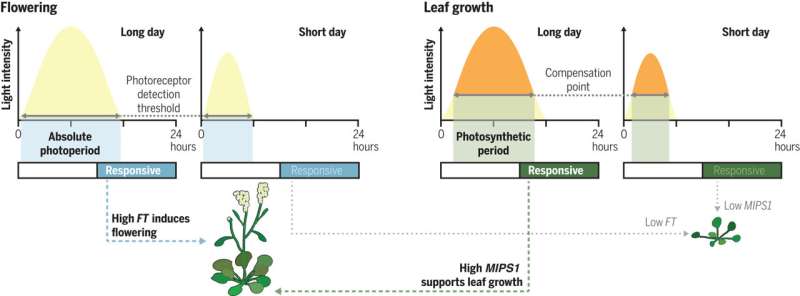This article has been reviewed according to Science X's editorial process and policies. Editors have highlighted the following attributes while ensuring the content's credibility:
fact-checked
trusted source
proofread
Light duty: Distinct molecular pathways control growth, flowering in plants

It's well known that plants have a fine-tuned ability to sense changes in the season by how much daylight they're exposed to, yet scientists observed more than a century ago that plants sometimes grow during one season and flower in another. Most research in the decades since, however, has focused on seasonal flowering, leaving that classic observation unstudied.
In a new study, a Yale-led research team revisits this idea that growth and flowering sometimes occur in different seasons, asking whether these two phenomena therefore might be controlled by separate molecular mechanisms within the plants.
The answer is yes, they report Feb. 9 in the journal Science.
Previously, researchers had identified a specific gene mutation that can hinder flowering, a discovery that has allowed scientists to track in great detail the molecular changes that are triggered by daylength, and thus allow plants to flower.
In the new study, researchers discovered specific genetic mutations that suppress growth, but do not affect the plant's ability to flower. The study was led by Joshua Gendron, associate professor of molecular, cellular, and developmental biology in Yale's Faculty of Arts and Sciences, and first author Qingqing Wang, a postdoctoral associate in Gendron's research lab.
They then found that molecular pathways that control flowering and growth are distinct.
Plants produce flowers based on the amount of light that they detect with photoreceptors, similar to those found in our eyes. However, seasonal growth is determined by the length of time photosynthesis actively occurs each day, the researchers say.
"We were surprised to find that plants can see one season for flowering and one season for growth in a single natural day," said Gendron. "They are completely separate from each other, which means that plants are experiencing two seasons simultaneously."
In agricultural production, understanding when a plant will grow and flower is critical. These new findings offer a potential pathway for using genetics to alter seasonal growth in important crop species.
"One of the other important benefits comes from the ability to maximize growth of crop species in greenhouses using controlled lighting," Gendron said. "Currently, energy consumption [related to these agricultural operations] is limiting for a lot of greenhouse crop growth."
More information: Qingqing Wang et al, Plants distinguish different photoperiods to independently control seasonal flowering and growth, Science (2024). DOI: 10.1126/science.adg9196
Provided by Yale University



















